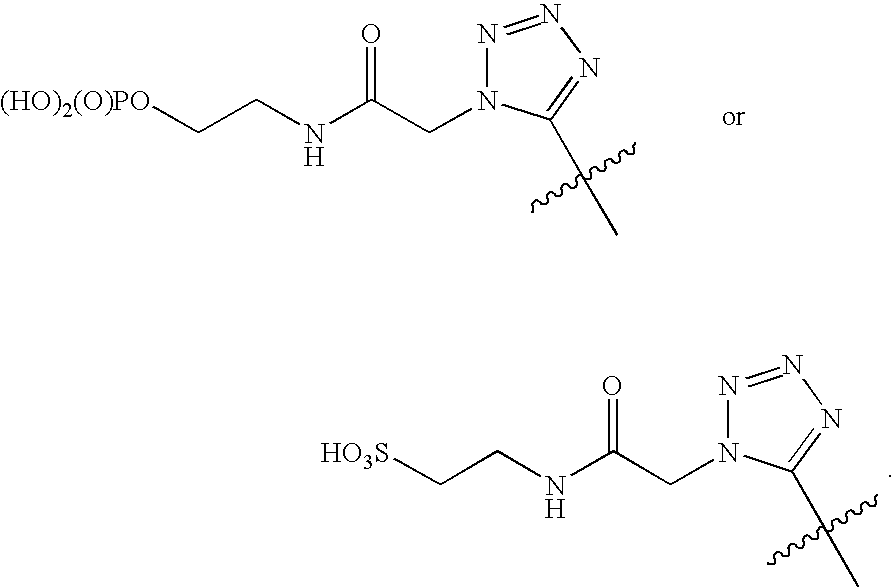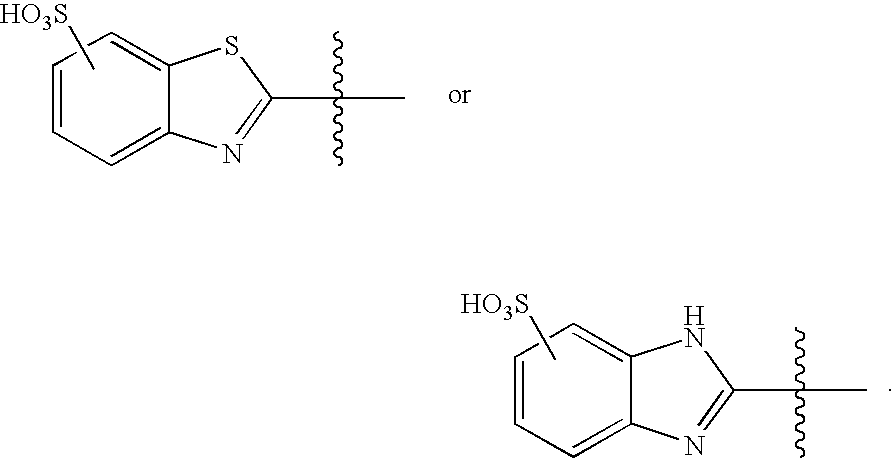Preparation and use of mixed mode solid substrates for chromatography adsorbents and biochip arrays
- Summary
- Abstract
- Description
- Claims
- Application Information
AI Technical Summary
Benefits of technology
Problems solved by technology
Method used
Image
Examples
example 1
Immobilization of Mercapto-benzimidazole Sulfonic Acid (“MBISA”) on Cellulose Beads
[0100]The purpose of this example is to demonstrate the preparation of a solid substrate comprised of a mercapto-alkyl linking group.
[0101]Wet cellulose beads (100 g) were washed extensively with water to eliminate salts and preservatives. The beads were treated sequentially with 100 ml of a 1 M sodium hydroxide solution, and with vigorous shaking, 10 g of allyl-bromide. The mixture was stirred overnight at room temperature to ensure complete reaction. The derivatized beads were then washed extensively with water to remove excess reagents and by-products.
[0102]The allyl-cellulose derivative was treated with 100 ml of deionized water, 5 g of N-bromosuccinimide, and 8.3 g of potassium bromide. The resultant suspension was agitated and then treated with phosphoric acid to adjust the pH to 3.8–4.0. The mixture was further agitated for 1 hour at room temperature and then washed with water.
[0103]To the resu...
example 2
Immobilization of MBISA on Cellulose Beads Via a Mixed Mercapto- and Ether-Containing Linker
[0104]The purpose of this example is to demonstrate the preparation of a solid substrate comprised of a mercapto- and ether-containing linking group.
[0105]Cellulose beads (100 g) were washed as in Example 1. The beads were treated sequentially with 40 mL of a solution 0.5 M sodium hydroxide, 25 ml of ethanol, and 20 g of allylglycidyl-ether with shaking. The mixture was stirred overnight at room temperature to ensure complete reaction. The derivatized beads were then washed extensively with water to remove excess reagents and by-products.
[0106]The desired product was obtained by bromination and then treatment with MBISA according to the procedure in Example 1.
example 3
Immobilization of Mercapto-benzimidazole Sulfonic Acid (MBISA) on Zirconium Oxide Composite Beads
[0107]This example demonstrates the preparation of a solid substrate comprised of a composite solid support material.
[0108]A composite resin (100 g) of wet porous zirconium oxide beads containing within the pores a hydrogel of 5% agarose was washed extensively with water. The beads then were treated with 50 ml of 1 M sodium hydroxide and, with vigorous shaking, 5 g of allyl-bromide. The mixture was stirred overnight at room temperature to ensure complete reaction. The derivatized beads were then washed extensively with water to remove excess reagents and by-products.
[0109]The allyl-cellulose derivative was then treated with a solution of 2 g of N-bromosuccinimide and 4 g of potassium bromide in 50 ml of demineralised water. Under agitation, the suspension was further treated with 0.5 gram of 85% phosphoric acid. The mixture was agitated for 1 hour at room temperature and then washed with...
PUM
| Property | Measurement | Unit |
|---|---|---|
| Force | aaaaa | aaaaa |
| Volume | aaaaa | aaaaa |
| Volume | aaaaa | aaaaa |
Abstract
Description
Claims
Application Information
 Login to View More
Login to View More - R&D
- Intellectual Property
- Life Sciences
- Materials
- Tech Scout
- Unparalleled Data Quality
- Higher Quality Content
- 60% Fewer Hallucinations
Browse by: Latest US Patents, China's latest patents, Technical Efficacy Thesaurus, Application Domain, Technology Topic, Popular Technical Reports.
© 2025 PatSnap. All rights reserved.Legal|Privacy policy|Modern Slavery Act Transparency Statement|Sitemap|About US| Contact US: help@patsnap.com



